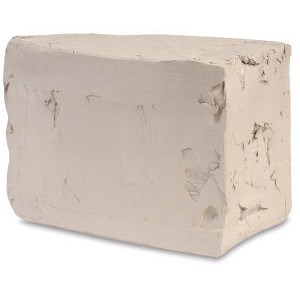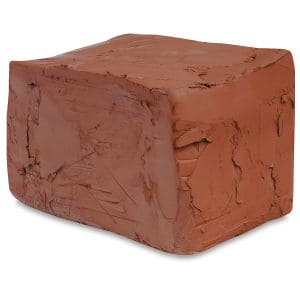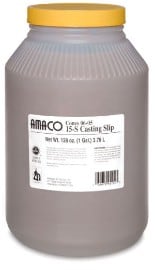Your cart is currently empty!
12 Top Tips to Start a Pottery Hobby – A Beginners Guide
Published:
Last Updated:
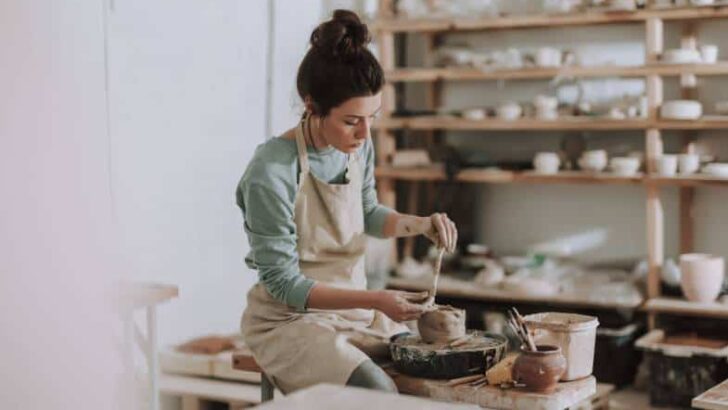
Affiliate Disclaimer
As an affiliate, we may earn a commission from qualifying purchases. We get commissions for purchases made through links on this website from Amazon and other third parties.
If you want to start a pottery hobby, it can be hard to know where to start. Like all new ventures, it can feel like there is an overwhelming amount of information to learn.
But take heart, you only need to take one step at a time. I have put together this handy list of top tips to help you start a pottery hobby.
How to Start a Pottery Hobby
Here are 12 top tips on how to start a pottery hobby:
Tip 1: Choosing a Technique When You Start a Pottery Hobby
There are 3 main ways to make pottery. It’s helpful to choose one technique to focus on when you start. The three main ways to make pottery are:
- Using a pottery wheel, also known as wheel-thrown pottery
- Hand-building pottery
- Slip casting
Lots of potters use a combination of all three methods. But when you start a pottery hobby it’s a good idea to focus on the one that appeals to you most.
You can always branch out later and learn the other pottery methods when you have a little more experience. So, take your pick and get started!
Here is an overview of what each method involves. Have a think about which one appeals to you most.
Using a Pottery Wheel
A pottery wheel is a piece of pottery equipment, that allows you to spin clay. As the wheel spins, you shape the clay into a bowl, mug, vase, or vessel. This is known as throwing pottery.
Some pottery wheels are designed so that you can stand at them. Most are designed so that you can sit at them whilst you work. Others are designed to go on a tabletop and you can sit or stand, whichever is your preference.
Like all hobby equipment, there is a dizzying array of makes and models of pottery wheels. But don’t worry, you can get an inexpensive wheel, that is more than good enough to start a pottery hobby. I will take a look at getting a pottery wheel a little later in this post. Or you can take a look at this article on choosing a pottery wheel.
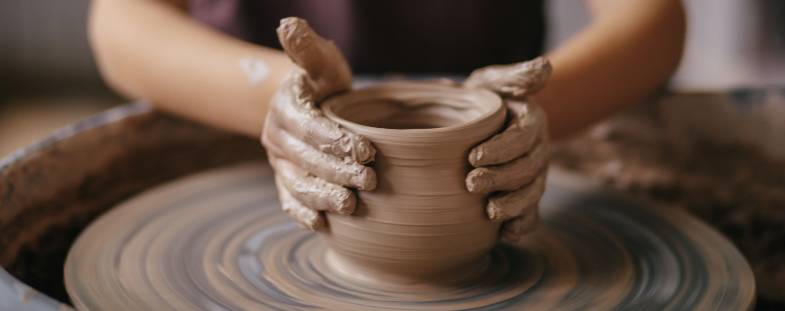
Advantages of Using a Pottery Wheel:
I will admit to having a bias here. My preference for making pottery is to use a pottery wheel. The main reason for this is that using a pottery wheel is a lot of fun. It’s challenging, satisfying, fun, and therapeutic all in one. Ooh, and you can make beautiful pottery too. What’s not to like?
Hand Building Pottery
Hand-building pottery is exactly as it sounds. You are making pottery without a potter’s wheel. Your hands are your main tools, and you use a variety of techniques to build your pots with your hands.
I have a background in sculpture and what I love about hand-building pottery is that it feels like sculpting.
The 4 main ways of hand-building pottery without a potter’s wheel are:
- Pinch pots
- Coil pots
- Slab pottery
- Using a mold to make your pottery
Advantages of Hand-Building Pottery:
You can start a pottery hobby using hand-building techniques with next to no equipment. You will need some clay and a few simple tools, but other than that, you are good to go.
Slip Casting
Slip is clay that has been mixed up with enough water so that it makes a liquid. You can get slip of different thicknesses. Some is sticky and thick like a paste. Other slip is thin and smooth enough to pour.
Slip casting involves pouring smooth slip into a plaster mold. The slip dries out in the mold and takes on the shape of the mold. Once it is dry it can be popped out of the plaster mold easily. Once removed from the mold the slip-cast pottery can be finished in a number of ways.
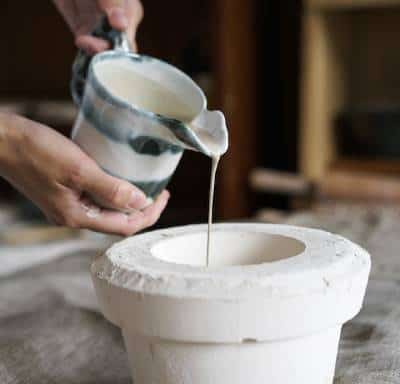
Advantages of Slip Casting:
Using a mold allows you to make multiple versions of the same piece. And you can make very neat evenly proportioned pieces using a slip cast.
Tip 2: How to Choose Clay When You Start a Pottery Hobby
There are lots of different types of clay to choose from. The first question to ask yourself is whether you want to use pottery clay or air dry clay.
Air Dry Clay
As the name suggests air dry clay can be dried in the open air without being fired in a kiln. There are different types of air dry clay. Some is polymer and feels a bit like plastic. This is good if you want to make toys and jewelry. But if you want to make pottery, then you need a clay that is more like pottery clay.
You can get air dry clay that looks and feels like clay. Often this is normal pottery clay that is reinforced with fiber so that it dries hard without needing to be fired.
Some air dry clay can be used in many of the ways that pottery clay can be used. For example, some air dry clay can be used on a potter’s wheel. This is a good example by Amaco. It handles like ceramic clay, but does not need to be fired in a kiln.
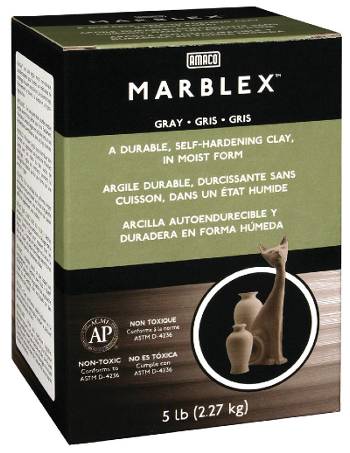
Amaco Air Dry Clay – View on Blick
The Limitations of Using Air Dry Clay
Some, but not all, air dry clay is designed to either air dry or be fired in a kiln. Pottery that is air-dried is limited in terms of how you can use it. It is not food safe or waterproof. This is because, although it has hardened, it is still porous. There are ways of sealing air dry clay so that it’s water-resistant. However, it is hard to make it fully non-porous.
Air dry clay is also weaker than pottery clay. The advantage of firing clay is that when it becomes ceramic, it also gets much harder. As such it is more resilient and tends to survive longer.
Pottery Clay / Ceramic Clay
In contrast to air dry clay, pottery clay is fired in a kiln. When it’s been fired in a kiln, it becomes ceramic. This means that it can no longer be dissolved in water.
There are three main types of pottery clay. They are:
- Earthenware
- Stoneware
- Porcelain
If you are new to making pottery, the different types of clay can feel a bit overwhelming.
To help you narrow it down a bit, I would suggest avoiding porcelain when you start a pottery hobby. Porcelain is beautiful, and some potters do learn their craft with it. However, it’s not the easiest clay to work with.
If you like a challenge, porcelain might be right for you. But if you want to make your life a bit easier, start using either earthenware or stoneware.
When it is fired, stoneware pottery is harder and less porous than earthenware. But actually, either earthenware or stoneware pottery is fine when you start a pottery hobby.
Good To Know…
If you are wheel throwing pottery, it’s best to use a smooth clay body. Some clay has added grit, sand, or grog in it. This gives the clay strength and makes it easier to build and sculpt with.
But it’s tough on the hands if you are throwing on the wheel. It can feel gritty and abrasive and the clay passes underneath your hands. So, choose a smoother clay. Either of these is a good choice for wheel throwing:
However, if you decide to hand build, choosing a clay with a bit of grog can be a good idea. Grog or sand gives the clay mechanical strength, so it keeps its shape more easily when you are building. A good option would be something like this:
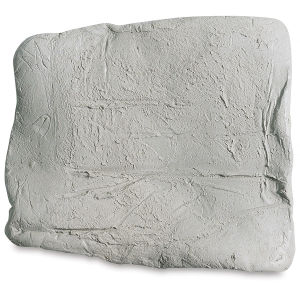
Standard Ceramic 105 White Clay with Grog
Tip 3: Essential Equipment When You Start a Pottery Hobby
The equipment that you need depends on what method of pottery making you want to start off with.
This gives you an idea of the bigger pieces of kit that you will need to start a pottery hobby:
- Throwing Pottery: A potter’s wheel
- Hand Building pottery: No particular equipment essential
- Slip Casting: Some plaster molds
Buying a Potter’s Wheel:
Pottery wheels vary in size, price, and sophistication. They range from around $150 to $2000.
But when you start out, it’s really not necessary to get a top-of-the-range wheel. In fact, when you start, my feeling is that it’s wise to start with something less expensive. That way you can try out your new hobby and see how you get on with it.
You may find you love wheel throwing and you want to give up your day job to become a potter. If so, that’s great! That might be the time to spend thousands on a wheel. But at the start a budget of around $150-250 is fine. You can get a perfectly adequate pottery wheel in that price range.
A few things that you should look out for when you are buying your first pottery wheel.
Some pottery wheels are designed to go on a tabletop. Others have legs and are designed to be placed on the floor.
Most pottery wheels have foot pedals, so you control the speed of the wheel head with your foot. However, some are designed with hand levers. It’s really a matter of personal choice which you prefer. I would say however that your hands get covered in clay when you are throwing. For that reason, I prefer using a foot pedal control.
There are a number of wheels on the market that are good when you start a pottery hobby. This is the model that I used for a long time when I first started ceramics. It served me well and I learned a lot on it.
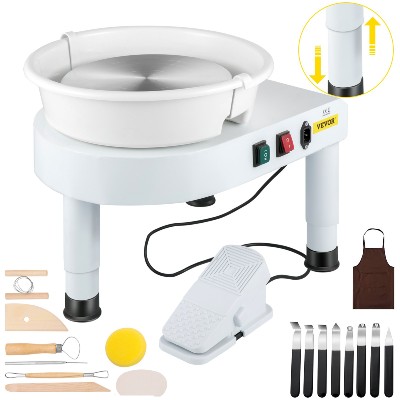
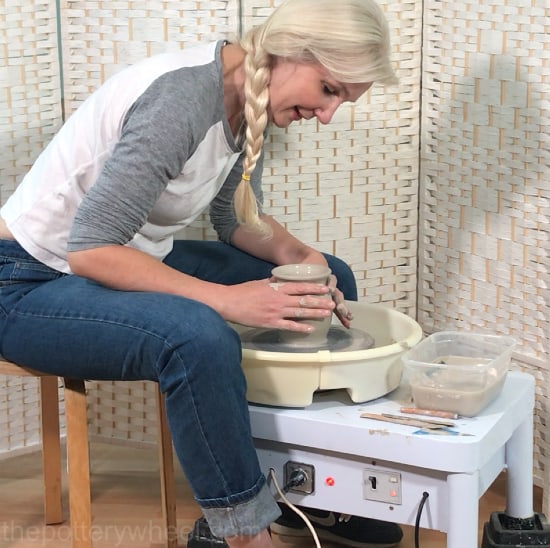
Once you have developed your skills and confidence, you can upgrade, but for now, this is a really good choice. You don’t need to spend a fortune to get an effective piece of kit.
Equipment for Hand Building Pottery
As mentioned, the beauty of hand-building is that you don’t actually need to buy any equipment to get started. You will, of course, need some clay, but other than that, your costs are minimal.
If you want to make pinch pots or coil pots, all you need is clay.
Slab building your pottery does involve making slabs of clay. You can do this with a rolling pin or a slab roller. But even that is not entirely necessary when you start. It’s possible to make a nice even slab of clay without a rolling pin.
Equipment for Slip Casting
If you decide that slip casting is the way to go, you will need to get some plaster molds. You will also need some casting slip to pour into your molds.
Casting Slip
Some potters make their own casting slip from leftover scraps of clay that they have used on other.
It’s simple to make. You mix clay scraps with water to make a paste.
This will save you money, but if you are just starting out, you won’t have leftover scraps. So, you will need to buy some casting slip.
Plaster Molds
You can either buy or make your plaster molds. Plaster molds can seem a little pricey for a relatively small piece of plaster. However, what you need to remember is that they are reusable. Potters will use plaster molds, again and again, so you can make a lot of pieces from one mold.
Alternatively, if you like a bit of DIY, plaster molds are actually quite easy to make. And the beauty of making your own mold is that you can make it exactly as you want.
Tip 4: Handy Pottery Tools
As you learn how to make pottery, you will probably build up a collection of your favorite pottery tools. However, when you start a pottery hobby, there are a few tools that are essential to get going.
You can buy a pottery starter kit. This will include everything that you need to get going. Usually, with a starter kit, you end up paying less than you would if you bought each piece separately. Plus, you know that you haven’t missed anything.
Mudtools are a very good brand. Most of my favorite tools are by Mudtools. I’d recommend this one as a really good starter kit.
However, you may prefer to buy your tools separately as you go along and build up your collection. These are some of the tools that I use ALL the time and could not do without. You will find that you add to these as you go along. But this is what you will need to start a pottery hobby.
- Wire clay cutter
- Rib tools
- Wooden tools
- Needle Tool
- Sponges
- Sponge on a stick
- Chamois leather
- Shredder
- Trimming tool(s)
- Wooden bats
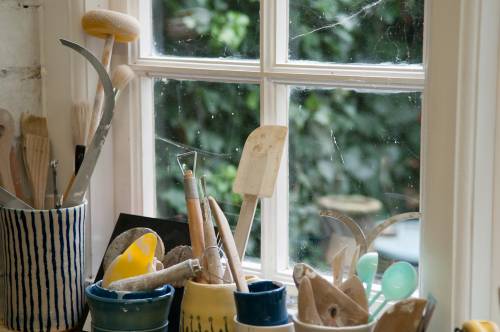
Tip 5: Preparing Your Clay
So, the big day is here. You have your clay, and you have a few essential tools to get you started. What next? The next thing you need to do is prepare your clay for pottery.
Well, before you make anything out of clay, you need to do something called ‘wedging’.
What on earth is wedging? Well, in order to make clay useable you need to do a couple of things, they are:
- Get rid of any air bubbles in the clay
- Wake the clay
- Align the clay particles
If you fire pottery that has air bubbles in it, it can crack or explode in the kiln. This is because as the kiln heats up, moisture in the clay turns to steam at 212F. As it turns to steam it expands into air pockets in the clay. This causes the air pockets to crack under the pressure.
To avoid your pottery exploding in the kiln, you need to get rid of air bubbles in the clay. And your piece needs to be bone dry before it is fired.
Wedging clay is the way to get rid of air bubbles in your clay. Some potters describe wedging as being like kneading bread dough because the action is similar. However, when you are kneading dough, you are pushing air into the dough. When you are wedging, you are getting rid of the air from the clay.
In addition to getting rid of the air bubbles, wedging wakes the clay up, and makes it more workable. It also aligns the clay particles so that it is easier to throw or mold.
There are a number of different wedging techniques. This handy video will give you an overview of the different methods.
Tip 6: Taking a Class When You Start a Pottery Hobby
It’s a great idea to take a pottery class at your local college or pottery studio. There are a few reasons why taking a class is good:
- Your tutor will instruct you, but also you can ask them about techniques as your questions arise.
- Access to equipment such as pottery wheels and kilns.
- Learning from your fellow students.
- Motivation and encouragement.
- Avoiding learning bad habits. Bad habits can be hard to unlearn.
Tip 7: Online Learning
There are some great resources online to help you start a pottery hobby. These resources include pottery forums, groups, and online tutorials.
Pottery and Ceramics Forums
The Ceramic Arts Network has a great forum where you will find answers to most pottery-related questions you have. Alternatively, if you join the community, you can also post questions and get responses from very experienced potters.
Social Media Pottery Groups
There are some good pottery groups on social media forums like Facebook. One good example is Hobby Potter Life, which is run by Tammy Jo Schoppet. This group is a wealth of information, inspiration, and experience.
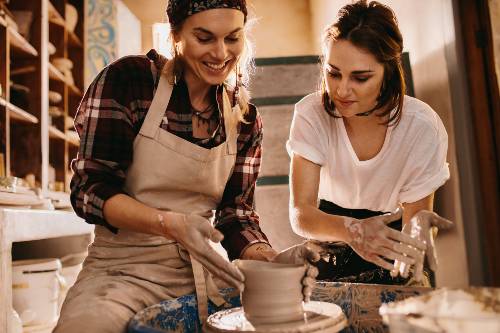
Online Pottery Courses
If getting to a local class is tricky for whatever reason, there are some great online pottery tutorials.
YouTube is a great resource, and whatever your pottery question, someone has probably made a video about it. If you subscribe to The Pottery Wheel YouTube channel, you will get updates as new videos are added. Subscribe here! It’s FREE!
Udemy also runs some great online pottery courses. If you aren’t familiar with it, Udemy is an online teaching resource. They run courses about hand building and wheel throwing for different levels of experience. I’d recommend checking them out.
TIP 8: Decorating Your Pottery
So, what happens when you have made your pottery, either on the wheel, by hand, or slip casting? What is the next step?
Pottery is usually fired in a kiln twice. The first fire is called the bisque fire, this is when it turns from raw clay to ceramic material. The second fire is the glaze fire, and this is when a glazed finish is melted onto the surface.
Before your pottery goes into the kiln for a bisque fire, it is referred to as greenware.
The next step after making your pottery is to decorate it. Some kinds of pottery decorations are done on greenware before the bisque fire. Other decorations are done after the bisque fire and before the glaze.
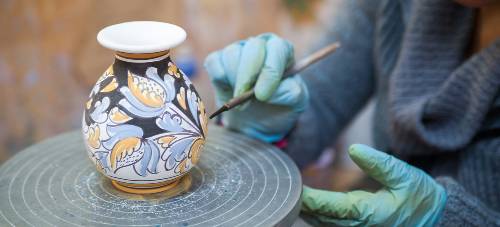
How you choose to decorate your pottery depends on the effect you want to achieve. There are many ways to decorate pottery. This is a really fun part of the process, and you can experiment with techniques as you learn.
Here are just a few ways of decorating your pottery:
- Using underglaze. This can be painted, sprayed, stenciled, sponged, or silk screen printed onto your pottery. It’s really very versatile.
- Carving your pottery. Some carving (or incising) techniques include Sgraffito and Mishima.
- Decorating your pottery with slip. One example of this is slip trailing.
- Glazing your pottery.
- Burnishing.
Tip 9: Firing your Pottery
As stated above, pottery is usually fired in two stages. The first stage is the bisque fire and the second firing is the glaze fire.
You might be wondering why pottery is fired in a kiln at all. Well, the first fire is used to drive out moisture, organic matter, and carbon compounds from the clay.
As the clay and clay particles lose these elements, the clay shrinks and becomes rigid. This is called sintering. Once the clay has undergone this change, it has become ceramic and can no longer be dissolved in water. In short, the bisque fire changes the clay into hard ceramic material.
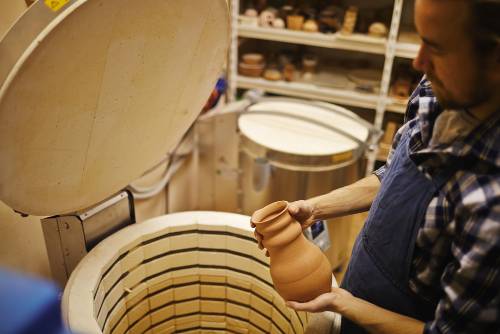
After the clay has been bisque fired, glaze can be applied in liquid form. It dries on the ceramic surface. The pottery is then glaze fired.
During the glaze fire, the glaze melts and forms a glassy non-porous coating on the pottery. This can make the pottery waterproof and therefore usable for dinnerware and holding water. But also, glaze can make your pottery look beautiful.
How do You Get Your Pottery Fired?
Well, there are two options. Either you can buy a kiln or you can take your pottery along to a local kiln firing service. The kiln firing service will fire your pottery for you.
If you’re just beginning to start a pottery hobby, you may want to wait before you invest in a kiln. Lots of hobby potters do have kilns. In fact, there is a whole range of kilns specifically aimed at hobby potters.
However, kilns are expensive, they take up space, they require ventilation and they sometimes have specific power requirements.
If you’re buying a kiln to use in your home there are quite a few factors to take into consideration.
Plus using a kiln involves another learning curve. When you start a pottery hobby, you have enough to learn already. I’d recommend waiting until you have built up your pottery skills before you think about getting a kiln.
So, how can you find someone else with a kiln who will fire your work for you? This is a good question and luckily I have written an article specifically on this topic! Lots of people have kilns and they will be happy to fire your work.
You may be very lucky and happen upon a super generous potter, who will fire your work without charging. But 9 times out of 10, you will need to pay a fee for getting your work fired. Normally, however, this charge is fairly small. Much cheaper than buying and running your own kiln.
If you want some great ideas for how to find a pottery firing service near you, check out my article. You will be firing your pottery in no time.
Tip 10: Transporting your Pottery Safely
When you have found a local pottery firing service, you need to get your pottery to the kiln safely.
This may sound simple. How hard can it be? Well the thing about unfired clay in its bone dry state, is that it’s very fragile.
Before it has been fired, pottery lacks almost all internal structural strength. One bump en route to the kiln can cause cracks and breaks. Handles, mug lips, and pouring spouts are particularly vulnerable.
Fortunately, there are some simple ways to protect your greenware as you transport it to the kiln. Check out this article on how to move your pottery from A to B without losing your favorite pieces.
Similarly, bisque fired pottery that has been glazed but not yet glaze fired is also fragile. The bisque ware is unlikely to break, but an unfired layer of glaze will crumble and rub off easily. You need to be careful how you package up unfired glazed ware, so the glaze doesn’t get damaged in transit.
Tip 11: Practice, Practice, Practice
The most important key to getting good when you start a pottery hobby is to practice. If you watch a video of an experienced potter at work, they will make the process seem effortless. It’s one of the reasons why people often refer to pottery as being mesmerizing or relaxing to watch.
But make no mistake, most of that effortless skill has come from practice. Don’t be disheartened if your first attempts don’t look as great as you had imagined in your mind. That would be like sitting down at a piano and expecting to play without having had any lessons.
Practice and you will get better and better. Enjoy the learning curve and develop your own style.
Tip 12: (Don’t) Compare and Despair!
I love this saying. If you continually compare yourself to others, you will end up feeling despairing about yourself. This, I think, is true of most of us. And I think it’s also true when you start a pottery hobby.
There are lots of amazing potters out there, who produce beautiful work. Try to use their knowledge and skill as a source of inspiration and learning, rather than feeling intimidated.
We all start off at the beginning. Most of us, with the exception of the occasional prodigy, suck when we start at something new. Just keep doing what you do and you will get there.
I have found that most potters are very generous with their knowledge and very supportive. For the most part, they want to support and encourage their fellow potters. Find your pottery tribe and they will help you along in your pottery journey.
Final Thoughts on How to Start a Pottery Hobby
When you start a pottery hobby it can feel a little overwhelming. Use the above tips to guide you through the beginning stages. Pretty soon you will start to gather knowledge, gain skills, and make lovely pottery. And who knows, once you have learned a few new pottery skills, you might fancy making a living by becoming a professional potter. If you’d like to know how to work as a potter, you can check out my post on that subject here.

